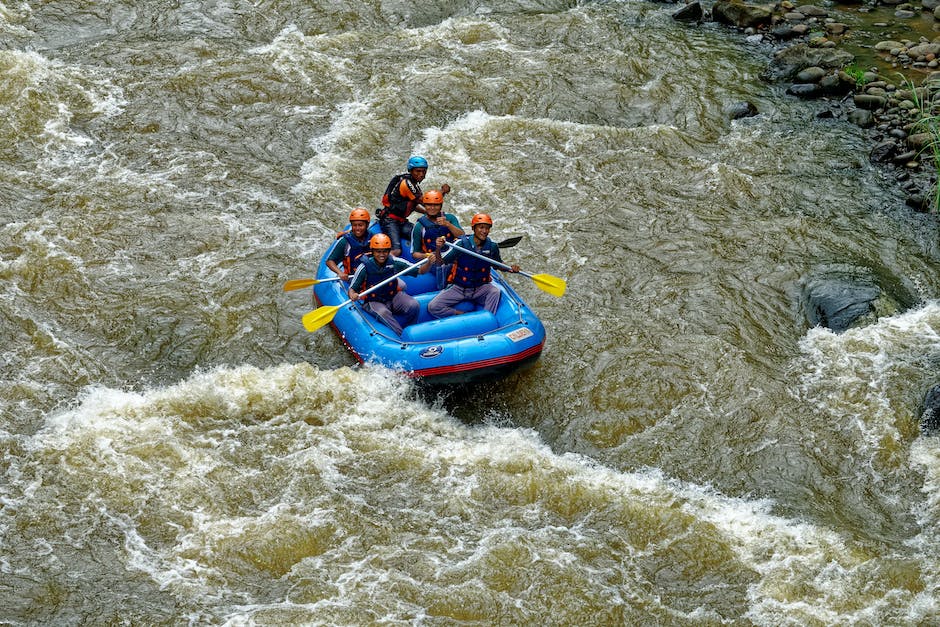What To Wear Rafting

When it comes to rafting, you want to make sure that you are wearing the proper clothing that will keep you both comfortable and safe. There are a few key items that you should consider when deciding what to wear rafting. It is important to think about the weather, the kind of activity that you will be participating in, and the type of water that you will be on. This article will provide some helpful tips on what to wear rafting.When rafting, it is important to wear appropriate clothing that will keep you safe and comfortable throughout the activity. It is best to wear a pair of water-resistant shoes with good grip on the soles. Additionally, you should wear layers of quick-drying clothes such as synthetic materials like nylon or polyester. These will help regulate body temperature while keeping you warm and dry. A swimsuit may be necessary if you plan to swim during your rafting adventure. Finally, don’t forget a hat and sunglasses to protect your eyes from the sun.
Basic Equipment for Rafting
Rafting is an exciting outdoor activity that can be done in a variety of settings, from calm lakes to raging rivers. In order to make the most of your rafting experience, you must have the right equipment. This includes both safety gear and specialized items designed for use on the water. Here are some of the basics that you will need in order to get started.
The most important piece of equipment is a life jacket. These are designed to keep you afloat in case you go overboard, and they come in various sizes for adults and children. You should also have a helmet, which will protect your head if you fall off the raft or hit a rock or other obstacle.
A paddle is essential for maneuvering your raft through the water. Paddles come in various lengths and materials, so it’s important to choose one that works best for your size and strength as well as the type of water you’ll be navigating. Other pieces of equipment that may be necessary depending on your situation include wetsuits, fins, spray skirts, and waterproof bags for storing items like snacks and sunscreen.
You’ll also need some basic items such as sunscreen, hats, sunglasses, and clothing appropriate for the weather conditions. Make sure all these items are securely stowed away when not in use so they don’t interfere with your rafting experience. Finally, bring along plenty of water to stay hydrated throughout your trip.
With these pieces of equipment on hand, you’ll be ready to take on any adventure that comes your way while rafting!
Water-Resistant Clothing
Water-resistant clothing is a great choice to stay dry and comfortable in wet weather conditions. It helps keep you warm and protected from rain, snow, and other elements. Water-resistant fabrics are made from polyurethane or other synthetic materials that repel water instead of absorbing it. These fabrics are lightweight and breathable, making them ideal for outdoor activities like running, hiking, and camping. They also provide excellent protection against abrasions, wind, and cold temperatures.
When selecting water-resistant clothing, look for garments with a waterproof rating of at least 5K to 10K. This rating indicates the garment’s ability to resist water penetration up to a certain amount of pressure. The higher the rating, the more waterproof the fabric is. Additionally, look for garments with taped seams to ensure water does not seep through any stitching or openings.
It’s important to note that while water-resistant clothing can help keep you dry during light rain or snowfall, it will not protect you in torrential downpours or fierce storms. If you plan on being outdoors in these conditions for an extended period of time, it is best to wear waterproof clothing with a rating of 10K or higher. Waterproof jackets are typically designed with sealed seams and are made from thicker materials than their water-resistant counterparts.
Best Footwear for Rafting
When going rafting, it is essential to wear the right footwear. Not only will it provide comfort and protection, but it will also help avoid injuries. The best footwear for rafting depends on the type of water you’ll be rafting in and the activity you’ll be doing. For instance, if you are rafting on a lake, then sandals are an ideal option. They provide plenty of grip and flexibility for walking on slippery surfaces while still providing enough support to your feet. However, if you’re rafting in rapids, then closed-toe shoes are a must. These shoes provide better ankle support and can protect your feet from debris or rocks that you may encounter in the water.
No matter what type of footwear you choose, make sure it is comfortable and fits properly. It should also have good traction to prevent slipping on wet surfaces. Wearing two pairs of socks can also help keep your feet dry and comfortable while protecting them from blisters caused by friction between your foot and the shoe material. After all, having dry and comfortable feet is important when spending long hours on the water!
Sun Protection while Rafting
When engaging in any outdoor activity, sun protection is always important. This holds especially true for rafting, as the reflection of the sun off the water can be damaging to a person’s skin. When going rafting, it is important to wear sunscreen with an SPF of 30 or higher and make sure it is reapplied throughout the day. It is also important to wear a hat for further protection from the sun, and to wear protective clothing such as long-sleeved shirts and pants if possible. Sunglasses should also be worn to protect eyes from UV rays. For added protection, people should bring along a beach umbrella or canopy for breaks during the day.
It is also important to stay hydrated while rafting, so bringing plenty of water and drinks with electrolytes is essential. Consuming foods high in Vitamin C can also help protect against skin damage from the sun. Make sure everyone in your party has adequate sun protection before heading out on your rafting adventure!

Dressing in Layers for Rafting
Rafting is an enjoyable outdoor activity, but to remain comfortable and safe it’s important to dress appropriately. Layering your clothing is the best way to ensure that you can adjust to changing weather conditions and maintain comfort while out on the water. Layering also helps trap body heat and provide insulation against cold temperatures. Here are a few tips for dressing in layers for rafting.
Start with a lightweight, moisture-wicking base layer, such as a long-sleeve shirt or leggings made from synthetic material like polyester or merino wool. This layer should fit closely to the skin without being too tight or restrictive. Next, add a mid-layer of insulating material like fleece or a synthetic jacket that will help retain heat while still allowing air to circulate. Lastly, wear an outer shell that is waterproof and breathable, such as an all-weather jacket made from nylon or Gore-Tex fabric. The outer layer should be large enough to fit over all of the other layers so you can remove it if needed without having to take off any of your other clothes.
In addition to dressing in layers, you should also wear shoes that provide good footing on wet surfaces and are secure enough to stay on your feet when moving around in a raft. Waterproof sandals or closed-toed shoes are best. Make sure that any items you bring along with you are stored securely in waterproof bags or containers, as well as secured safely inside your raft.
Whether you’re going out for a day trip or heading off for an overnight adventure, proper layering will help keep you warm and comfortable during your time on the water. With these tips for dressing in layers for rafting, you’ll be prepared for whatever Mother Nature has in store!
Essential Accessories to Bring While Rafting
Rafting can be a thrilling and exciting experience, but it is important to come prepared with the right accessories. Whether you are hitting the rapids for the first time or an experienced rafter, here is a list of essential items you should bring along:
A life jacket is an absolute must. Not only will it keep you afloat if you fall out of your raft, but it will also provide protection against any rocks or other obstacles in the water. Be sure that your life jacket fits properly and is suitable for your size and weight.
A helmet is another crucial item when rafting. Head injuries can be incredibly dangerous, especially in whitewater conditions, so having a helmet on offer protection from any potential hazards. Also, helmets can help keep your head warm and dry in cold temperatures or rainy conditions.
A waterproof bag is essential for storing all of your belongings while on the river. Look for one that has several compartments to make organizing items easier and makes sure that it is fully waterproof so that nothing inside gets wet or damaged.
If you plan on spending several days rafting, then camping gear such as a tent and sleeping bag should also be packed. These items will ensure that you have a comfortable place to rest after long day’s out on the river.
Sunscreen and sunglasses are also important items to bring along when rafting as they help protect against sunburns and harmful UV rays from the sun. Look for waterproof sunscreen if possible as this will stay on longer in wet conditions than regular sunscreen would.
Finally, having an emergency kit with items such as first aid supplies, fire starters, flashlights and other basic survival gear is always recommended when going out into nature. This way if something unexpected happens while out on the river then you’ll be prepared with whatever supplies are needed to handle the situation safely and effectively.
Overall, these essential accessories should help ensure that your rafting experience runs smoothly and safely so don’t forget to bring them along!
Choosing the Right Life Jacket for Rafting
When it comes to rafting, choosing the right life jacket is key. It is essential to have a life jacket that fits properly, is comfortable, and provides you with the highest level of safety. There are several different types of life jackets designed specifically for rafting, and each one has its own benefits and drawbacks. It is important to understand these differences in order to make an informed decision when selecting your life jacket.
The first type of life jacket designed specifically for rafting is the Type III Personal Floatation Device (PFD). This type of PFD is usually made of nylon with foam inserts for flotation, and it fits snugly around the torso so that it won’t ride up or slip off in rough water. The Type III PFD also features built-in flotation material that can help keep you afloat if you become separated from your raft. However, this type of PFD does not provide as much protection against hypothermia as other types because it does not provide insulation from cold water.
The second type of life jacket designed specifically for rafting is the Type V PFD. This type of PFD is usually made with a combination of neoprene and nylon fabric, providing additional insulation from cold water temperatures. The Type V PFD also features additional pockets that can be used to store items such as food or first aid supplies. Although this type of PFD provides more protection than a Type III PFD, it can be bulky and uncomfortable if worn in hot weather.
Finally, there are inflatable life jackets designed specifically for use while rafting. These jackets are lightweight and comfortable, making them ideal for warmer climates or long river trips. Inflatable life jackets must be manually inflated when needed; however they provide excellent buoyancy when inflated properly. In addition, some inflatable models feature extra pockets or compartments that can be used to store items such as snacks or emergency supplies.
When selecting a life jacket for rafting, it is important to carefully consider all of your options before making a purchase. Make sure to take into account factors such as climate conditions, body size and weight, comfort level, safety features desired, budget constraints, and other personal preferences when choosing the right life jacket for your needs. With a little research and some careful consideration you should be able to find the perfect fit!

Conclusion
Rafting can be a great way to spend time with friends and family, while experiencing the outdoors. It’s important to choose clothes that provide warmth and comfort, while also allowing you to move freely. A full wetsuit is recommended for colder temperatures, while a swimsuit or rash guard is sufficient for warmer climates. You should also wear shoes with good traction on the river, and consider bringing a change of clothes in case you get wet in the water. By following these tips, you can stay safe and comfortable during your rafting outing.
No matter how you choose to dress, make sure that you’re prepared for the elements and have fun! Rafting is an exciting activity that can create lasting memories with friends and family alike. With the right gear and preparation, it can be an enjoyable adventure for everyone involved.
